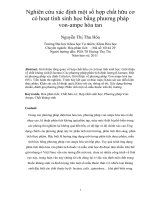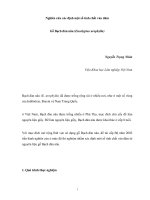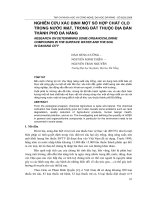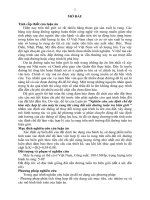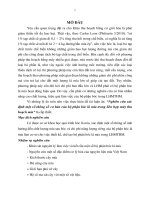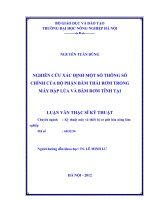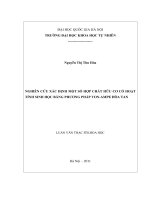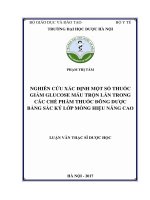Nghiên cứu xác định một số thông số hợp lý của quá trình cắt thân cây ngô sau thu hoạch tt tiếng anh
Bạn đang xem bản rút gọn của tài liệu. Xem và tải ngay bản đầy đủ của tài liệu tại đây (1.14 MB, 26 trang )
THAI NGUYEN UNIVERSITY
THAI NGUYEN UNIVERSITY OF TECHNOLOGY
Vu Van Dam
DETERMINING PROPER PARAMETERS OF THE
CHOPPING PROCESS OF HAVESTED CORN STALKS
Specialty: Mechanical Engineering
Code: 9 52 01 03
SUMMARY OF DOCTORAL THESIS IN ENGINEERING
Supervisor
Assoc. Prof. Dr Nguyen Quoc Tuan
Prof. Sc. Dr. Pham Van Lang
THAI NGUYEN – 2020
1
Introduction
1. Motivation
Agricultural residues, including stems, leaves and other components
(often thrown away after harvested), have been considered to be rich
in organic polymers such as lignin, cellulose, hemiaellulose, protein
and lipids [74]. In Vietnam, agricultural residues are mainly from
rice and corn (maize), often used as direct feed, or silage for
livestock feed [2-4, 7, 8, 15, 17]. According to statistical
calculations [111], the total annual amount of agricultural residues in
the world is about 3736 million tons, which can replace 2283 million
tons of coal, 1552 million tons of oil or 1847 million cubic meters of
gas. This output has increased steadily over the years to meet the
growing world’s population. On average, the annual volume of
residues from wheat, rice, maize, and soybean are 763 million tons,
698 million tons, 1730 million tons and 417 million tons,
respectively.
Corn is the third most important food crop after rice and wheat [27],
widely grown around the world [45, 97]. Corn stalks account for
one-third of the annual production compared to other agricultural
residues [41]. In Vietnam, maize is not only an important cereal and
food, but also recently plays a role as a raw material plant for the
production of environmentally friendly ethanol - E5 [10]. In
particular, a new trend is being developed that direct cultivation of
biomass maize will also increase the demand for post-harvest
processing.
Chopping of harvested corn stalks is an important preliminary step in
the processing of animal feed, biomass pellet production as well as in
other processing processes. For example, the corn stalk should be
chopped into 6.4 mm lengths for gasification [95], 1 mm long for
chemical conversion [102], 2-10 mm for composting yeast forage, or
5-6 mm long for briquetting [76]. On the industrial scale, chopping
can be done by specialized chopping components, which are
combined at the rear of harvesters.
In developing countries such as Vietnam, farmers often burn all
kinds of agricultural residues on fields. This is not only a waste but
also a negative impact on the environment, such as air pollution or
causing forest fires. One of the reasons is that the cost of chopping is
2
still high. Because agricultural residues are often very cheap,
depreciation, labor and especially energy consumption will account
for a large proportion of the cost of semi-finished products.
Therefore, finding solutions to reduce the amount of energy
consumed when chopping has been carried out by many international
studies [24, 34, 37, 43, 78, 87, 107]. In Vietnam, scientific
publications were found to mainly focus on design techniques based
on productivity, durability, etc. for harvesting machines combined
with chopping of some agricultural products such as maize [ 3, 4, 6,
17], straw after harvesting rice [19] or banana stalks [1], processing
pineapples [9], cutting fibers from coconuts [13]. These designs
focus on solving the chopping function according to the principles of
cutting discs, cutting drums, designed to achieve the chopping
productivity. However, the issue of energy saving has hardly been
mentioned by previous studies.
Many international studies have been done to reduce cutting force
and cutting power by improving the tool design and selecting a
reasonable cutting mode. Reducing shear force is considered as one
of the optimal solutions to reduce energy consumption. Moreover,
reducing the cutting force will also contribute to reducing the size of
the machine's parts and thus reducing the size of the machine.
However, because energy consumption is calculated by the multiple
product of the shear force and shear velocity, in several cases if the
chopping process has a small shear force with high velocity, it may
required a large power consumption. In some studies, empirical
models using a pendulum have been developed to measure the shear
force and shear power required when chopping agricultural residues
[32, 39, 66, 71, 85, 100]. Factors assessed include the effects of the
type of cutting blade, the different cutting angles [24, 27, 44, 96]
Several other studies have evaluated the influence of the straight
blade sharp angle, the rotation speed of the disc-type knives to the
cutting ability of corn stalks [32, 78, 85, 90, 103]. A new approach of
is applying biomechanics to design and manufacture of knife profiles
based on the tooth profile of insects such as mantis, corn-eating
worms, grasshoppers, hair trimmers [64]. , 65, 71, 72, 100] .... Finite
element method and experimental simulation results show numerous
benefits in terms of shear force and power consumption reductions.
However, this type of blade profile would be difficult in
3
manufacturing, sharpening and thus would be difficult to apply in
commercial machines. There have been many studies to find
solutions to save energy consumption [27, 28, 38, 44, 49, 66, 68, 69].
However, the solution to the multi-objective optimization problem
for both shear forces and energy consumption, especially for
chopping machines using counter edge [24, 34, 37, 43, 78, 87, 107]
is still a remained knowledge gap.
Another research direction to save energy in the process of chopping
agricultural residues is to identify proper working parameters [28,
31, 33, 49, 50, 58, 59, 61, 78, 88, 89].
To date, the problem of concurrently reducing the force and cutting
power directly on chopping machines, using counter edge has not
been solved. No studies have been found to evaluate the
simultaneous effects of working parameters and structural
parameters on cutting force and power on such machines. For the
above reasons, the topic: "The study identifies some reasonable
parameters of the process of cutting corn stalks after harvest" with
urgency and practical significance.
2. Aims, objectives and scopes of the present research
2.1. Research aims
The main aims of this study is to determine important structural
parameters and proper operational parameters of the chopping
process of havested corn stalks in order to concurrently minimize the
cutting force and cutting power.
Research subjects:
The study subjects are some main parameters affecting shear force
and energy consumption of corn stalk choppers.
2.2. Research objectives
Objectives of this study are as following:
+ Designing and manufacturing an experimental device that can
control the input parameters, obtain all output parameters of the
chopping process, meeting the requirements of the experimental
study;
+ Identify parameters that have strong effects on the force and
cutting power when chopping corn stalks after harvesting;
4
+ Identify a set of design and operation parameters of chopping
machines to minimize cutting force and cutting capacity;
+ Develop a profile model of chopping blade to ensure design
parameters.
2.3. Scopes
The scope of the study is to conduct experiments of chopping single
corn stalks in order to determine the specific cutting force and
cutting power, providing a basis for calculating the problem of
cutting process. Experiments are carried out in laboratories.
Parameters to be evaluated include: feed angle, approach angle and
cutting speed. The harvested corn stalks used as experiments were
stored under the same conditions. It is assumed that mechanical
properties and moisture content of experimental samples are the
same.
The research methods used in this study include design of
experiments, applied statistical analysis and mathematical regression
techniques.
3. Application-oriented significances
+ The results can be applied to design and manufacture of
agricultural chopping machines. Although only experimented with
corn stalks, the significant effects of the feed angle and the approach
angle were due to the grain texture of the stem. Most other stalks and
agricultural residues also have such grain structure. Therefore, the
trend of influence of the above angles can be applied when chopping
other plants.
+ The research results of the thesis can be used in design calculations
and selection of working parameters for disk chopping machines,
contributing to the exploitation and processing of agricultural
residues for production and life, reduce energy costs, thereby
contribute to reduce the environmental pollution.
4. The new contributions of the study
+ Studied the cutting force and cutting power in chopping of corn
stalks for an intermediate cutting speed (Ranged from 1 to 10 m/s).
This is a new contribution to this research trend in the world.
5
+ Evaluated the simultaneous effects of approach angle, feeding
angle and cutting velocity to the cutting force and cutting power in
chopping process of corn stalks. This is a new contribution compared
to previous scientific publications.
+ Carried out a couple of conflict objective functions, including
the cutting force and cutting power. Thereby, the multi-objective
optimization problem for both cutting force and cutting power of
corn stalks has been solved. Compared to a typical case of practical
use of chopping machines, applying the optimal parameters not only
reduced the cutting force by 2.3 times, but also dropped down the
power consumption by 4 times. Identified a set of working
parameters, which serves as a basis for designing and manufacturing
chopping machines of agricultural residues, applied in production
practices.
+ Proposed a blade profile using logarithm spiral and evaluated
its advantages compared to blades using straight and curved edges.
Using the proposed profile allows to keep the approach angle as
constant along the blade edge. Consequently, the optimum value of
the approach angle can be maintained belong the cutting edge of the
blade.
+ Developed an algorithm to automatically calculate and draw
the blade shape with different sizes. The embedded software module
in AutoCAD environment allows to create technical drawings and to
export the data sets for tool machining on CNC machines.
6. Thesis structure
Chapter 1. Literature review
Chapter 2. Theoretical basis of chopping process of agricultural
residues
Chapter 3. Design, manufacture and evaluate the experimental
system
Chapter 4. Experimental study and development of the blade profile
CHAPTER 1. LITERATURE REVIEW
1.1. Introduction
6
1.2. State-of-the-art of corn production in the world and in the
country
1.2.1. Corn production in the world
1.2.2. Maize production in the country
1.3. Some characteristics of the maize after harvested
1.3.1. Humidity
1.3.2. Specific gravity
1.3.3. Mechanical properties
1.3.4. Sliding friction between corn stalks and other materials
1.4. Processing agricultural residues
1.4.1. Processing animal feed
1.4.2. Processing commercial products
1.5. Agricultural residues chopping machines
1.5.1. Drum chopper
1.5.2. Disc chopper
1.5.3. Chopping machine using tooth knives
1.6. Experimental studies
1.6.1. Assignments of angle parameters
1.6.2. Pendulum-impact for experimental device
1.6.3. Vertical rotational disk device
1.6.4. Universal testing machine
1.7. Some results in saving energy consumption
7
Chapter conclusions
Chapter 1 presented an overview of the issues directly related to the
topic of the thesis, specifically as follows:
Maize is one of the most important crops in the world and in
Vietnam. The statistics show that there is an increase in productivity
and output. Chopping of corn stalks after harvested is a mandatory
preliminary step of further processing.
The specific parameters of corn stalks that affect the chopping
process have been confirmed in previous studies. Important
parameters include: the moisture content, elastic modulus, friction
coefficient between corn stalks and some materials.
Experimental models for harvesting machines would not be fully
applied to practical chopping machines, due to the inconvenience to
implement fedding angle. The experimental model used inconvenient
impact pendulum to measure shear force, which is difficult to vary
the cutting speed. Some other types of experimental devices using
univeral testing machines are not convenient to vary the cutting
speed and feed angle. Therefore, this study uses a real chopping
machine with rotational disk to implement experimental study.
CHAPTER 2. THEORETICAL BASIS OF CHOPPING
PROCESS OF AGRICULTURAL RESIDUES
2.1. Introduction
2.2. The chopping principle
2.3. Basis of chopping process dynamics
2.4. Multi-objective optimization
Chapter conclusions
Chapter 2 presented a summary of the theoretical basis and the
cutting principles of the chopping process. The contents of this
chapter provided a basis for the study of dynamics and energy
consumption of corn stalk chopping. Some important contents are
summarized as follows:
There are two basic principles of the process of cutting agricultural
stalks, including: 1) impact cutting, the relative movement between
8
the knife and the material tree (cutting motion) performed in the
normal direction; 2) shear cutting, cutting motion combines both
normal and tangent directions. Compared to impact cutting, the
shear-cutting process significantly reduces the cutting force. In order
to keep the stalks in the wedge-shaped clearance of the cutter and the
counter edge, the velocity of the slide should be set based on the
friction coefficient between the stem and the tool material.
Cutting force and power consumption are two objective functions
that have a conflict of interest. Therefore, it is necessary to solve the
optimal problem simultaneously for both above mentioned criteria.
The multi-objective problem identifies each criterion in accordance
with cutting technology steps: applying two expected functions (2.8)
and (2.9); Implementing experimental study on a real chopping
machine (cutting) to concurrently optimize the two objective
functions.
In order to clarify the research question, it is necessary to develop an
experimental device similar to commercial chopping machines,
having capable of varying the cutting speed and the correlation
angles between the knife and the stalks. These contents will be
presented in the next chapter.
CHAPTER 3. DESIGN, CREATION AND EVALUATION OF
TESTING EQUIPMENT SYSTEM
3.1. Introduction
3.2. Design of experimental system
3.2.1. Experimental model
The input and output parameters in this study are shown in Fig 3.1
and Figure 3.2.
Fig 3.1. Experimental schema
9
Fig 3.2. Relative position of the stalk in the cutting process: 1) cutting tool,
2) hinge joints, 3) force sensor, 4) maize stalk, 5) counter shear, 6) spring.
3.2.2. Structural design
Some of the structural design are presented in Fig 3.3 and 3.4.
(a)
(b)
Fig 3.3. Diagram of the drive principle of a chopping machine a) Structure
of a commercial machine, b) Proposed structure: 1) electric motor; 2) Belt
transmission; 3) drive shaft; 4) flat knife disc; 5) Coupling; 6) Torque
sensor; 7) Load cell; 8) counter shear
Fig 3.3. A 3D model of the
experimental setup. 1) belt wheel,
2) spindle shaft, 3) knife, 4) screw,
5) clamp, 6) maize stalk, 7) counter
shear.
Fig 3.4. Relative position of the
stalk in the cutting process
3.3. Selecting measuring and data collection equipment
3.3.1. Cutting force sensor
The cutting force sensor Kistler 9712A500 (Figure 3.6) was used to
measure the impact force.
10
(a)
(b)
Fig 3.5. (a) Force sensor Kistler 9712A500 và (b) Force sensor holder
3.3.2. Measure the friction force
The friction force was used by a mini load cell with a capacity of 100
N (Figure 3.7).
3.3.3. Torque sensor
A torque sensor RTT-200 (Figure 3.8) was used to measure torque
transferred via the spindle.
Fig 3.6. Load cell FSSM-100
Fig 3.7. Torque sensor RTT-200
3.3.4. Equipment for collecting and processing data
A DAQ model NI USB-6008 was used to collect data.
3.3.5. Software for designing and analyzing experimental data
The Minitab software was used to design of experiments and
analyze the results. OriginLab software was used to analyze the data.
3.4. Manufacture and installation of experimental systems
The experimental device was implemented as shown in Figure 3.9.
Fig 3.8. Practical Experimental Setup
3.5. Operation and some results of the system survey
3.5.1. Operating experimental systems
11
3.5.2. Measure cutting force and torque
(a)
(b)
Fig 3.9. Example of experimental cutting force and power consumption
signals
3.5.3. Measurement of sliding friction between counter shear and
corn stalk
Fig 3.10. Friction measurement experiment
Bảng 3.1. Experimental results of sliding friction measurement
Mass (kg)
Normal force
(N)
Friction force
(N)
Friction
coefficient
2.5
4.5
6.5
8.5
24.525
44.145
63.765
83.385
11.971
21.146
28.147
34.907
0.488
0.479
0.441
0.419
Angle
friction
(0 )
26.02
25.59
23.82
22.72
Friction coefficient was calculated as the ratio of friction force
and normal force. The friction angle was then calculated from the
coefficient of friction according to the following formula:
arctan
(3.3)
12
3.6. Chapter conclusions
In this chapter, input parameters were determined including: feed
angle, approach angle, cutting speed and the gap between the cutting
edge and the counter edge. The experimental device has been
developed to allow for infinite control of these parameters, meeting
well the data requirements according to theory of design of
experiments. The system of measuring and data collection
equipments allows to measure output parameters simultaneously
including cutting force and cutting torque to ensure reliability. An
experimental model was developed to determine the coefficient of
sliding friction between corn stalks and cutter material.
Experimental studies, carried out on the above mentioned
experimental system will be presented in the next chapter.
CHAPTER 4. EXPERIMENTAL RESULTS AND
DEVELOPMENT OF CUTTING NETWORK MODELS
4.1. Introduction
4.2. Experimental description
Three sets of experiments were performed including: screening test;
optimization of single objective, and multi-objective optimization
experiments.
4.3. Screening experiment
Table 4.1. Experimental Factors in Screening Experiments
Approach angle
()
0
60
Level
Low (-1)
High (+1)
Feed angle ()
Gap (mm)
0
50
1
2
Table 4.2. Results of screening Experiments
StdOrder
1
2
3
4
5
6
7
8
a
0
60
0
60
0
60
0
60
b
0
0
50
50
0
0
50
50
d
1
1
1
1
2
2
2
2
Fc
305.77
204.49
235.18
164.59
293.50
241.32
373.30
155.38
STT
13
14
15
16
17
18
19
20
a
0
60
0
60
0
60
0
60
b
0
0
50
50
0
0
50
50
d
2
2
2
2
1
1
1
1
Fc
287.36
225.97
367.16
146.17
296.57
247.46
247.46
155.38
13
StdOrder
9
10
11
12
a
0
60
0
60
b
0
0
50
50
d
1
1
1
1
Fc
311.91
250.53
225.97
161.52
STT
21
22
23
24
a
0
60
0
60
b
0
0
50
50
d
2
2
2
2
Fc
284.29
219.84
361.02
152.31
The main effect graph of factors (Figure 4.1) shows that the effect of
approach angle is the most significant, and then the following
factors: 2nd, the interaction effect between approch angle and the feed
angle; 3rd is the interaction effect between approach angle, feed angle
and the gap between the cutting edge and the counter edge, 4th is the
interaction between feed angle and gap; the fifth is the feed angle,
and finally is the gap between the cutting edge and the counter edge.
Fig 4.1. Pareto Chart Obtained from Screening Experiments
4.4. Experiment to optimize shear force when cutting slowly
4.4.1. Screening experiment
Bảng 4.3. Experimental Factors in Screening Experiments
Approach angle, a (0)
0
10
Level
Low (-1)
High (+1)
Feed angle, b (0)
0
10
Fig 4.4. Design and Results of Screening Experiments
StdOr
der
1
2
3
Approach angle a (0)
Feed angle b (0)
Cutting force Fc (N)
0
10
0
0
0
10
348.74
189.14
232.11
14
StdOr
der
4
5
6
7
8
9
10
11
12
Approach angle a (0)
Feed angle b (0)
Cutting force Fc (N)
10
0
10
0
10
0
10
0
10
10
0
0
10
10
0
0
10
10
198.35
351.81
201.42
247.46
195.28
370.23
207.56
222.91
210.63
The cutting force was expressed as a function of approach angle, a
and feed angle, b as:
Fc = 248.0 – 47.6*a – 30.2*b
(4. 1)
4.4.2. Downhill experiment to find minimum region
Fig 4.2. Contour Plot of Initial
Experiments
Fig 4.3. The Cutting Force at
Steepest Descent Steps
The model of cutting force as a response function of the two input
factors are depicted in Figure 4.2. The results obtained are presented
in Figure 4.3 and Table 4.5. As can be seen, the general vicinity
of the minimum cutting force would potentially be located
around step 6. The final optimum experiments should be
implemented nearby this point.
Table 4.5. Results of Steepest Descent Experiments
Symbol
Approach angle a (0)
Encode
Real value
Feed angle, b (0)
Encode
Real value
FC (N)
Initial
0
0
348.74
Initial
10
10
195.28
15
1
+10
0,7
+7
-
Start
1
20
0,00
20
183.1818
+
2
30
0,7
27
152.5661
+ 2
3
40
1,4
34
139.5095
+ 3
4
50
2,1
41
113.3962
+ 4
5
60
2,8
48
98.33087
+ 5
6
70
3,5
55
78.24374
+ 6
7
80
4,2
62
106.3657
4.4.3. Optimal experiment
The optimal experiments were implemented follow Central
Composite Design (CCD) plan, as shown in Table 4.6. The results
was then analyzed by ANOVA technique. Summary of the cutting
force model is depicted in Fig 4.4.
Table 4.6. Design and Results of CCD Optimal Experiments
Std
Ord
er
1
2
3
4
5
6
7
8
9
10
11
12
13
Approh
ch angle
a, (0)
37,3
72,7
37,3
72,7
55,0
55,0
55,0
30,0
80,0
55,0
55,0
55,0
55,0
Feed
angle, b
(0 )
38,1
38,1
57,9
57,9
48,0
48,0
48,0
48,0
48,0
34,0
62,0
48,0
48,0
Cutting
force
(N)
107,79
75,58
81,72
84,93
90,93
90,93
90,93
103,20
75,44
87,86
75,58
87,86
87,86
TT
14
15
16
17
18
19
20
21
22
23
24
25
26
Approhc
h angle
a, (0)
55,0
37,3
72,7
37,3
72,7
55,0
55,0
55,0
30,0
80,0
55,0
55,0
55,0
Feed
angle, b
(0)
48,0
38,1
38,1
57,9
57,9
48,0
48,0
48,0
48,0
48,0
34,0
62,0
48,0
Cutting
force
(N)
87,86
109,86
75,58
78,65
87,00
90,93
90,93
90,93
100,13
75,44
90,93
72,51
87,86
16
Fig 4.4. Analysis of Variance for Cutting Force
The cutting force was expressed as a function of approach angle,
a and feed angle, bas:
FC 210,1 3,132 a 2 0,409b 0,03293b 2 0,05574 ab
(4. 2)
This function was then used to carry out the optimal set of
input factors so as to obtain smallest cutting force. A contour plot
of the force model is shown in Figure 4.5b. From the figure, the
smallest cutting force would be obtained as less than 60 N if the
approach angle is of 70°-80°, coupled with the feed angle of 35°40°. Another set of parameters includes 30°-40° approach angle
and around 65° feed angle. Compared to a typical case in practice,
where commercial choppers use straight knifes with both
approach and feed angles are set to be 0°, where the cutting force
would be higher than 300 N (Figure 4.2), optimal input
parameters were found to reduce the cutting force by around 5
times.
(a)
(b)
Fig 4.5. Surface plot and Contour Plot of the Cutting Force
4.5. Multi-objective optimization of experiments
17
4.5.1. Description of the objective function
4.5.2. Optimization experiment
Table 4.7. Real values of experimental parameters.
Cutting velocity,
Approach angle,
Level (Coded)
V
a (0)
(m/s)
Low (-1)
4.40
0
Middle (0)
5.66
30
High (+1)
6.91
60
Table 4.8. Experimental tests and corresponding results.
Std
Or
der
1
V
a
b
F
4.4
0
0
2
6.91
0
0
3
4.4
P
tt
V
706.07
82.37
11
5.66
548.56
100.57
12
60 0
282.26
32.93
13
4
6.91 60 0
325.32
59.64
5
4.4
0 50
392.18
45.75
6
6.91
0 50
344.59
7
4.4
60 50
312.86
8
6.91 60 50
9
4.4
30 25
10
6.91 30 25
a
Feed angle, b (0)
0
25
50
b
F
P
0 25
485.1
72.77
5.66 60 25
327.59
49.14
5.66 30 0
359.39
53.91
14
5.66 30 50
312.86
46.93
15
5.66 30 25
367.25
55.09
63.17
16
5.66 30 25
364.98
54.75
36.50
17
5.66 30 25
293.59
44.04
425.04
77.92
18
5.66 30 25
243.74
36.56
313.99
36.63
19
5.66 30 25
236.94
35.54
210.87
38.66
20
5.66 30 25
230.14
34.52
The Analysis of Variance tables summarise the linear terms, the
squared terms, and the interactions of input parameters in the
response functions. As can be seen from both Fig 4.6 and 4.7, there
appeared significant p-values (smaller than the typical significance
level of 0.05) for the square terms (p=0.002 in Fig. 4.6 and p=0.004
in Fig. 4.7), as well as for the 2-way interactions (p=0.003 in Table
4.6 and p=0.013 in Table 4.7). This indicates that there are
curvatures in the response surfaces of the cutting force and the power
consumption. In Fig. 4.6, the small p-values for a (p=0.000) and for b
(p=0.002) indicate that the effects of those factors on the cutting
force are statistically highly significant. However, the cutting
velocity, V and the approach angle, a, but not b, are the factors
having significant effects on the power consumption, as shown in
Fig. 4.7. The p-values of the term “Lack-of-fit” appeared as high
18
values (greater than 0.05) in both Tables 4.6 and 4.7 indicate that the
regression models of the cutting force and of the power consumption
fitted the experimental data well.
Fig 4.6. Analysis of Variance of the
Force response
Fig 4.7. Analysis of Variance of
the Power response
(a)
(b)
Fig 4.8. The cutting force peak and power consumption as functions of
cutting velocity: a) when α=0 and β=0; b) when α=30 and β=35
The two functions were considered as conflicting objectives, as
illustrated in Fig. 4.8. The cutting force appeared to decrease with
higher cutting velocity with approach angle a=00 and feed angle b=00
(Fig.4.8(a)), whereas the power consumption increased with
increasing velocity. The difference between the trend of cutting force
and that of the power can also be observed in Fig.4.8(b), where
a=300 and b=350. On the one hand, the minimum cutting force is
sought so as to strengthen the machine elements. On the other hand,
saving energy is also an important issue either in designing or
19
operating the machine. The response optimisation was needed to
identify the combination of input variables that satisfy a set of tradeoff objectives.
The cutting force and power consumption were then modelled as
functions of input parameters by using regression. The equations of
the response characteristics, i.e. the cutting force and the power
consumption, as functions of input parameters, are obtained as:
F 411 151V - 19.72 a - 12.49b - 19.2V 2 0.1263 a 2 0.0695 b 2 1.196 Va
0.713Vb 0.1080 ab
2
2
2
P -41 44.8V - 2.545 a - 1.595b - 3.62V 0.01955 a 0.01131b 0.1080 Va
0.0555V b 0.01598 ab
(4. 3)
4.5.3. Determining optimal parameters
The optimal solution (Fig. 4.9 and 4.10) can provide the minimum
cutting force of around 238.8 N combined with the minimum power
consumption of 23.7 W. The optimal set of input parameters consists
of the cutting velocity of 4.4 m/s, approach angle of 41.8 and the
feed angle of 30.3. Compared to a typical case in practice, where
commercial chopping machines usually use straight knifes with both
approach and feed angles are set to be 0, the optimal parameters
were found to significantly reduce both cutting force and power
consumption. The optimal solution can provide a cutting force 233.8
N (around 2.5 times compared to 546.56 N) and power consumption
of 23.66 W, as around 4 times smaller than 100.57W.
Fig 4.9. Response optimisation of P and F.
20
Fig 4.10. Optimisation plot of the multi-objective problem
4.6. Compare, choose the blade profile
4.6.1. Straight blade
When cutting in the model of a scissor with a straight-edged
blade, the feed angle changes continuously along the blade, resulting
in a changing shear force, as shown in Table 4.9.
Table 4.9. Example of changing approach angle with a radius R1=100 mm
L(mm)
α ()
150
41,
8
175
34,
8
200
30,
0
225
26,
3
250
23,
58
275
21,
3
300
19,
47
325
17,
9
350
16,
6
375
15,
4
400
14,
4
4.6.2. Circular blade
Fig 4.11. Varying of the approach
angle of a curve knife
Fig 4.12. Variation of the appoarch
angle of the straight edge α1 and that
of the curve edge α2
21
Table 4.10. Statistics of the value of the feed angle at different cutting points
L (mm)
α straight blade
(0)
α Circular
blade (0)
15
0
41,
8
26,
1
17
5
34,
8
26,
4
20
0
30,
0
27,
3
22
5
26,
3
28,
6
25
0
23,
5
30,
2
27
5
21,
3
32,
1
30
0
19,
4
34,
3
32
5
17,
9
36,
8
35
0
16,
6
39,
6
37
5
15,
4
42,
7
40
0
14,
4
46,
2
4.6.3. Logarithm blade
Logarithmic spiral curves always have a constant angle α between
the tangent of the curve and the corresponding radius (Figure 4.13).
Figure 4.14 depicts an example where the angle is constant α=30at
different points along the cutting edge.
Fig 4.13. A logarithm curve
Fig 4.14. Constant tangent angle of the logarithm edge
22
4.7. Automatic design of uniform cutting blades
A software module to create the logarithm spiral was
implemented in AutoCAD environment. The module can
automatically build the technical drawing and export data of the
points along the cutting edge for manufacturing the cutter on CNC
machines.
4.8. Design, manufacture and test logarithm blade
Fig 4.15. A logarithm cutter
Fig 4.16. Drawing of cutter support
Fig 4.17. The manufactured
logarithm cutter on chopping
Fig 4.18. Cutting force at 5
different points along the logarithm
edge
4.9. Chapter conclusions
This chapter presents experimental results to determine a reasonable
set of parameters for cutting havested corn stalks. Some important
conclusions are summarized as follows:
The results of the screening test showed that the gap between the
chopping knife and the millet did not significantly affect the shear
force compared to the feed angle and approach angle.
The results of the single objective optimization experiments have
found a set of parameters as following: the approach angle is from
23
70° to 80°, the feed angle is from 35° to 40°. Accordingly, the
cutting force is 5 times lower than that of commercial chopping
machines.
The results of the multi-objective optimization experiments have
found the optimal set of parameters, including the cutting speed of
4.4 m/s, the approach angle of 41.8° and the feed angle of 30.3°.
Accordingly, the cutting force is more than 2.5 times, the power
consumption is reduced about 4 times compared to commercial
chopping machines.
From results of analysis, comparison and evaluation of experimental
data, a practical cutting blade using logarithm profile was designed
and successfully manufactured, which allows to maintain a constant
approach angle as given along the cutting edge. An AutoLisp
software module, applicable to automatically create drawing of the
logarithm profile in AutoCAD environment has been made. This
allows to perform completely automatically the process of
calculating the coordinates of the tool contour points, rendering data
files for manufacturing the cutter profile on CNC machines.
CONCLUSIONS
Compared to previous studies in the same field, the thesis has
achieved the following scientific and practical values:
Successfully designed experimental systems, measuring systems
and data collection directly on small commercial chopping machines,
using two rotation blades. This experimental system can provide a
similar cutting conditions to the actual environment in terms of
cutting speed and tool arrangement, better than the two common
models in many other publications using quasi-static and impact
cutting processes.
The knowledge gap in maize cutting studies has been found to be
that there are no studies on shear force and consumption power in the
chopping form at medium velocity (within the range from 1 to 10
m/s). Therefore, experiments have been carried out in this study to
collect and analyze data for a range of cutting speeds from 4 to 7
m/s. This result has been internationally reviewed and published in
high-ranking scientific journals (ISI Q1).
24
Detected two objective functions that have a conflict of interest,
including the cutting force and the cutting power. Thereby, the
problem of maximizing goals to reduce simultaneously the cutting
force and cutting power for each single cut of corn stalks was solved.
The optimal set of input parameters were found as following: the
cutting speed of 4.4 m/s, the approach angle of 41.8 and feed angle
of 30.3 . This set of parameters allows to obtain a cutting force of
238.8 N, a power consumption of about 23.7 W, as 2.5 times smaller
in cutting force and 4 times reduction of the power consumption,
compared to a conventional cutter with a feed angle and approach
angle of 0.
Successfully proposed, designed and fabricated a blade using
logarithm profile. Compared to flat and curved blades, the logarithm
profile provided a constant approach angle at all cutting positions
along the blade length. Consequently, the study results can be used to
improve the efficiency of the chopping process of agricultural
residues.
THE PROPOSAL FOR FUTURE RESEACH
Some suggestions for further studies are as follows:
Complete the solution of the optimal problem to simultaneously
meet many criteria, such as the cutting force, the power
consumption, cutting capacity, quality of chopped residues... Taking
into consideration the influence of many factors: figure parameters
study blade, correlation angle between knife and stalks, cutting
speed, mechanical properties of different type of residue materials…
Develop a dynamical model for a chopping machine using
logarithm blades.

